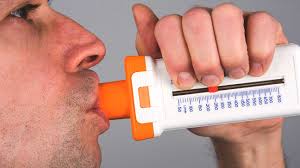Benefits of taking a PEF reading

Peak Expiratory flow (PEF) measurements are simply a measurement of how quickly one can blow air out of the lungs using a simple flow meter. These hand-held flow meters measure air breathed out in litres per minute (l/min) with the measured value displayed on the side of the PEF meter. Expectations of how much air you can blow using the meter varies based on age, height and gender . Peak expiratory flow measurements can sometimes be used to diagnose quickly if someone is having an asthma attack. If you are not breathing in air well into the lungs, there is no way you will be able to breathe a big volume of air out into the meter. Imagine your usual PEF reading is around the 500 mark. Recording, say a 300 reading, when the asthmatic patient is feeling unwell is a sure sign that the asthma condition could be flaring up and the airways are getting narrow. The user may need to ask for help at this time. Apart from helping to determine if an asthma attack is taking place, PEF readings


